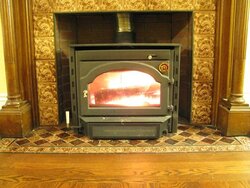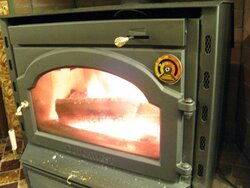Gooserider
Mod Emeritus
Looking at page 12 of the H-H manual, I don't think it would work, especially if you add in the incredible R-6.6 floor protection requirements I don't think you'd meet the clearance to the mantle among other things.
Also while the stove is pretty, I don't think it would go well with the existing FP - you'd have to many different materials, soapstone, then metal, then tile, then wood... It would look patched together. OTOH a plain steel front insert, or even something with cast decorations would look more like a uniform designed in from the start item instead of an afterthought add-in.
Gooserider
Also while the stove is pretty, I don't think it would go well with the existing FP - you'd have to many different materials, soapstone, then metal, then tile, then wood... It would look patched together. OTOH a plain steel front insert, or even something with cast decorations would look more like a uniform designed in from the start item instead of an afterthought add-in.
Gooserider



